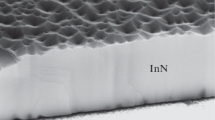Abstract
Values for the acceptor ionization energy, Ea, and compensating donor ionization energy, Ed, have been obtained from an analysis of variable-temperature photoluminescence data taken for a series of highly conducting nitrogen-plasma doped ZnSe thin films. Eawas found to be highly temperature dependent, with values ranging from Ea ~110 meV at low temperatures to ~60 meV at room temperature. The compensating donor ionization energy ranged from Ed ~31 meV at low temperatures to ~24 meVat room temperature. These results provide clear evidence of thenonhydrogenic nature of the nitrogen acceptor state in heavily doped ZnSe:N thin films and suggest that interstitial bonding of N, at two or more stable sites, may play a central role in the p-type doping and compensation of this material at high doping levels.
Similar content being viewed by others
References
K. Ohkawa, T. Karasawa and T. Mitsuyu,J. Cryst. Growth 111,797(1991).
R.M. Park, M.B. Troffer, CM. Rouleau, J.M. DePuydt and M.A. Haase,Appl. Phys. Lett. 57, 2127 (1990).
M.A. Haase, J. Qiu, J.M. DePuydt and H. Cheng,Appl. Phys. Lett. 59, 1272 (1991).
H. Jeon, J. Ding, W. Patterson, A.V. Nurmikko, W. Xie, D.C. Grillo, M. Kobayashi and R.L. Gunshor,Appl. Phys. Lett. 59, 3619(1991).
S.Y. Wang, I. Kauksson, J. Simpson, H. Stewart, S.J.A. Adams, J.M. Wallace, Y. Kawakami, K.A. Prior and B.C. Cavenett,Appl. Phys. Lett. 61, 506 (1992).
Z. Yu, J. Ren, B. Sneed, K.A. Bowers, K.J. Gossett, C. Boney,Y. Lansari, J.W. Cook, Jr., J.F. Schetzina, G.C. Hua and N. Otsuka,Appl. Phys. Lett. 61, 1266 (1992).
W. Xie, D.C. Grillo, R.L. Gunshor, M. Kobayashi, G.C. Hua, N. Otsuka, H. Jeon, J. Ding and A.V. Nurmikko,Appl. Phys. Lett. 60, 463 (1992).
H. Jeon, J. Ding, A.V. Nurmikko, W. Xie, M. Kobayashi and R.L. Gunshor,Appl. Phys. Lett. 60, 892 (1992).
W. Xie, D.C. Grillo, R.L. Gunshor, M. Kobayashi, H. Jeon, J. Ding, A.V. Nurmikko, G.C. Hua and N. Otsuka,Appl. Phys. Lett. 60, 1999 (1992).
J. Ren, K.A. Bowers, J.W. Cook, Jr. and J.F. Schetzina,J. Vac. Sci. Technol. B 10, 909 (1992).
Y. Lansari, J. Ren, B. Sneed, K.A. Bowers, J.W. Cook, Jr. and J.F. Schetzina,Appl. Phys. Lett. 61, 2554 (1992).
J. Qiu, J.M. DePuydt, H. Cheng and M.A. Haase,Appl. Phys. Lett. 59, 2992 (1991).
I.S. Hauksson, J. Simpson, S.Y. Wang, K.A. Prior and B.C. Cavenett,Appl. Phys. Lett. 61, 2208 (1992).
Ohkawa A. Ueno and T. Mitsuyu,J. Cryst. Growth 117,375 (1992).
D.J. Olego, Intl. Conf. on Solid State Devices and Materials (SSDM ’92), Tsukuba, Japan, 1992.
Z. Yang, K.A. Bowers, J. Ren, Y. Lansari, J.W. Cook, Jr. and J.F. Schetzina,Appl. Phys. Lett. 61, 2671 (1992).
A bound exciton ionization energy of 24.9 meV was obtained by subtracting the (D°,X) peak energy from the band gap energy E g at 4.2K. The ZnSe band gap at 4.2K was determined from the binding energy of the free exciton (19.9 meV). The free exciton binding energy was obtained by measuring the energy separation of the ground state and first excited state of the free exciton (14.9 meV) in an undoped sample. This equals three quarters of the exciton binding energy, assuming a hydrogenic model applies.
E. Karttheuser, R. Evrard and F. Williams,Phys. Rev. B 21, 648 (1980).
J.I. Pankove, Optical Processes in Semiconductors, (New York: Dover Publication Inc., 1975) p. 27.
N.W. Ashcroft and N.D. Mermin,Solid State Physics, (Philadelphia: Saunders College Press, 1876) pp. 577–580.
G. Burns,Solid State Physics, (Orlando: Academic Press, 1985) pp. 170–173.
E.W. Williams and R. Hall,Luminescence and the Light Emitting Diode, (Oxford: Pergaman Press, 1978) pp. 142–145.
M. Jaros,Deep Levels in Semiconductors, (Bristol, U.K.: Adam Hilger Ltd, 1982) pp. 209–257.
V.l. Fistul,Heavily Doped Semiconductors, (New York: Plenum Press, 1969) pp. 249–280
D.J. Chadi and N. Troullier,Physica B 185,128(1993).
D.J. Chadi and K.J. Chang,Appl. Phys. Lett. 55, 575 (1989).
D.J. Chadi,Appl. Phys. Lett. 59, 3589(1991).
Author information
Authors and Affiliations
Rights and permissions
About this article
Cite this article
Bowers, K.A., Yu, Z., Gossett, K.J. et al. Properties of highly conducting nitrogen-plasma-doped ZnSe:N thin films. J. Electron. Mater. 23, 251–254 (1994). https://doi.org/10.1007/BF02670631
Received:
Revised:
Published:
Issue Date:
DOI: https://doi.org/10.1007/BF02670631



